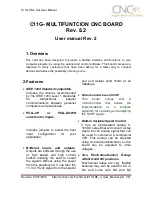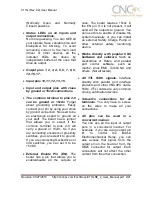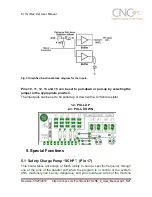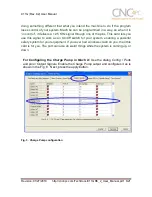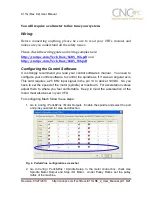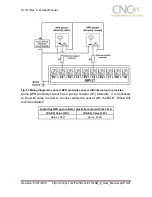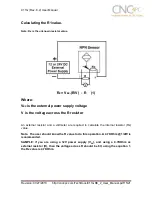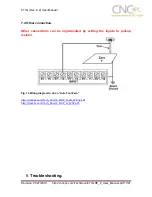
C11G (Rev.8.2) User Manual
Revision: 01/27/2010 http://cnc4pc.com/TechDocs/C11GR8_2_User_Manual.pdf 2/21
(Normally
Open
and
Normally
Closed) positions.
•
Status LEDs on all inputs and
output connections.
No more guessing. You can SEE all
your signals. Save valuable time and
brainpower for CNCing. To avoid
remaining current to the main load
(driver or other device), all the
indicator
LEDs
are
driven
by
independent buffers of the ones that
drive de output.
•
Output pins 1, 2, 3, 4, 5, 6, 7, 8, 9,
14, 16, 17.
•
Input pins 10, 11, 12, 13, 15.
•
Input and output pins with close
by ground or +5vdc connections
•
The common terminal to pins 2-9
can be ground or +5vdc.
Forget
about grounding problems. Easily
connect your pin by using your close
by ground connection. No need to be
an electronics expert to ground all
your stuff. The board has a jumper
that allows you to select if the
common terminal to pins 2-9 will
carry a ground or +5vdc. So if you
are connecting encoders or proximity
switches, you can select it to ground.
If you are connecting Geckodrives or
limit switches, you can set It to be
+5VDC.
•
External Enable Pin (EN).
The
board has a pin that allows you to
enable/disable all the outputs at
once. The board requires +5vdc in
the EN pin. If it is not present, it will
send all the outputs to ground. You
can use this to enable or disable the
system manually, or you can install
an external Safety Charge Pump or
other external safety monitoring
device.
•
Works directly with popular CNC
hardware and software.
Such as
Geckodrive or Rutex, and parallel
port control software, such as
mach2, Linux EMC, TurboCNC, and
others. (Not all tested).
•
All TTL 5VDC signals.
Interface
directly with parallel port interface
products and other CNC4PC cards.
5VDC (TTL) cards are very common
among automation devices.
•
Screw-On connections for all
terminals.
You only have to screw-
on the wires to make all your
connections.
•
All pins can be used in a
concurrent manner.
You can use all the input or output
pins in a concurrent manner. For
example, if you are using output pin
#1
to
control
the
Built-in
Electromechanical Relay, you can
also access that signal from the
output pin on the board or from the
DB25 connector for output. Each
connection will not affect the other
current from the other connection.

